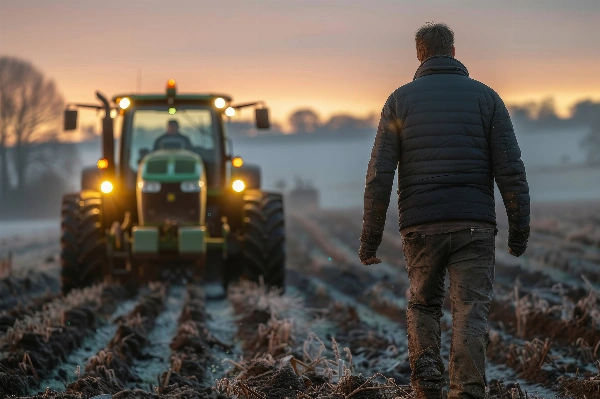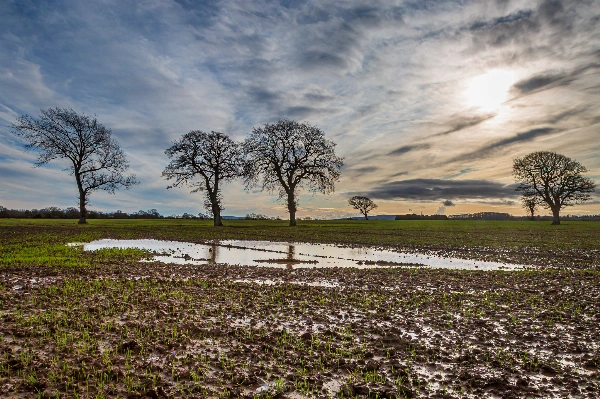As autumn leaves give way to frosty mornings, farmers across the country brace themselves for the challenges that winter brings. The colder months comes with a myriad considerations from soil health to agricultural equipment maintenance and repair tasks. While the task list may seem daunting at first, proper planning and execution can turn winter agriculture from a tough period into an opportunity to set your farm up for a thriving spring.
In this guide, we’ll delve into understanding winter's impact, crucial winterisation measures, adapting farming practices for cold weather, managing in snow and extreme conditions, and planning ahead for the coming year. Whether you're a seasoned farmer or new to winter agriculture, mastering farm management in winter is important for crop health, the longevity of your equipment, and the overall success of your winter farm.
Understanding the Impact of Winter on Your Farm
As winter draws in, we can expect to see many seasonal changes in the weather, and this does not come without its challenges for farmers, estate managers and agronomists. The most noticeable change is the amount of daylight hours we have. It can affect work schedules, plant growth and even dormancy periods! Crop farmers in winter often find themselves adjusting their routines and considering supplemental lighting for certain crops, particularly in greenhouse settings - a key aspect of what crop farmers do in the winter.
The biting cold can be unforgiving when farming in the winter. Freezing temperatures pose significant risks to crops on farms in winter, with winter-hardy varieties needing protection and others requiring greenhouse cultivation. Water systems on a farm in winter are particularly vulnerable, with irrigation pipes and water sources at risk of freezing, potentially disrupting essential winter agriculture operations. Even the soil on a winter farm is affected, with frozen ground impacting its structure and nutrient availability, which can have long-term effects on soil health and future crop yields.
Winter typically brings increased precipitation to farms in winter, often in the form of sleet and snow. Managing a farm in snow presents its own set of challenges. This can lead to waterlogged fields, increase the risk of soil erosion, and potentially cause flooding when the snow begins to melt. Crop farmers in winter frequently find themselves needing to implement additional drainage measures or adjust their field management practices to mitigate these risks - another crucial aspect of what crop farmers do in the winter.
Farm machinery faces additional strain during winter agriculture. Cold starts can be hard on engines, batteries may lose charge more quickly, and fuel systems might require winter-specific adjustments. These challenges underscore the importance of proper equipment maintenance and preparation to ensure readiness for both winter farm tasks and the upcoming spring planting season.
From an economic perspective, winter represents a slower season for many farms in winter. Production is typically reduced, operational costs may increase due to heating requirements for greenhouses or storage facilities, and there's often a need for diversified income streams to maintain financial stability. This period, however, offers valuable time for planning, maintenance, and skill development - all key activities in what crop farmers do in the winter.
Essential Steps for Winterising Your Farm in Winter
Preparing your farm for winter is crucial for successful winter agriculture. The process involves a series of interconnected tasks that collectively answer the question: "What do crop farmers do in the winter?" Let's explore these key steps that ensure your farm in winter not only survives but thrives during the colder months.
Protecting Crops and Soil on Farms in Winter
When farming in the winter, crop and soil protection become paramount. Mulching is a vital practice for winter farms, helping to protect soil from erosion and temperature fluctuations. Many crop farmers use cover crops as part of their winter agriculture strategy. These plants help prevent soil erosion, improve soil structure, and can even add nutrients to the soil. Choosing the right crops is also crucial for farming in the winter. Some vegetables like kale, brussels sprouts, and winter wheat are well-suited to colder temperatures and can be part of a successful winter farm plan.
Soil health requires special attention when preparing your farm for winter. Winter is an excellent time for soil testing, allowing you to understand your soil's nutrient content and pH levels and plan necessary amendments for the spring. This is a key task in what crop farmers do in the winter. Erosion can be a significant issue for a farm in winter, especially during spring thaws. Implementing erosion control measures like contour ploughing or installing windbreaks is an important part of winter agriculture.
Water management is crucial when farming in the winter to prevent damage from freezing temperatures. One of the first tasks when winterising farms in winter is to drain irrigation systems, preventing pipes from bursting due to frozen water expansion. For areas where some water access is necessary even in winter, installing frost-free hydrants can be a valuable investment for your winter farm. These measures ensure that your water systems remain functional and undamaged throughout the winter months.
Maintaining Equipment and Infrastructure for Winter Agriculture
Proper equipment care is essential for winter agriculture success. Preparing tractors, harvesters, irrigation equipment, and other equipment for cold weather is a crucial task on farms in winter. This includes changing to winter-grade oil, adding antifreeze, and ensuring batteries are in good condition. Properly cleaning and storing equipment not needed for winter agriculture helps extend its lifespan and ensures it's ready for use in spring.
Winter agriculture isn't just about maintaining your farm; it's also about preparing for the future. Winter is the perfect time to plan crop rotations, order seeds, and strategise for the coming growing season. Use the downtime on your farm in winter to repair fences, maintain buildings, and perhaps invest in new infrastructure to improve efficiency in the coming year.
Winter agriculture also offers a chance for farmers to invest in their own development. Many crop farmers use this time to attend workshops, take online courses, or catch up on the latest agricultural research and techniques. This continuous learning ensures that your farm in winter is not just maintaining its current state, but actively improving and preparing for future challenges and opportunities.
Managing Your Farm in Snow
Snow presents unique challenges and opportunities for winter farms. Keeping key areas of your farm in winter accessible is crucial. This might involve investing in snow removal equipment or planning snow storage areas that won't interfere with winter operations. However, it's important to remember that snow isn't always a hindrance in winter agriculture.
In some cases, snow can be beneficial for winter agriculture. A layer of snow can insulate winter crops and protect them from harsh winds and extreme cold. Understanding how to work with snow, rather than just seeing it as an obstacle, can be a valuable skill in farming in the winter. Some farmers even use snow management techniques to their advantage, such as using snow fences to create drifts that provide extra moisture to fields as they melt in spring.
Managing a farm in snow also involves considering the impact on wildlife and the local ecosystem. Snow can change animal movement patterns and affect the distribution of wild plants. Farmers engaged in winter agriculture often find themselves balancing the needs of their crops with the broader environmental context. This holistic approach to farming in the winter can lead to more sustainable and resilient agricultural practices year-round.
By following the steps in our guide and understanding these principles, crop farmers can make the most of the winter season, ensuring their farms in winter are not just surviving, but preparing for a thriving spring. Winter agriculture presents its challenges, but with proper planning and execution, it can be a productive and valuable time for any farm.
Planning for Spring During the Winter Months
While it might seem like spring is a lifetime away when you're knee-deep in snow, winter is actually the perfect time to get a head start on your spring planning. This is where the "what do crop farmers do in the winter" really comes into play.
Machinery
First up, let's talk about machinery maintenance and upgrades. Winter is the ideal time to manage your machinery and give your equipment a thorough once-over and address any issues. Maybe that old tiller has been on its last legs for a while now – winter is the time to either repair it or start shopping for a replacement. It's also a great time to consider any new technology or machinery that could improve your farm's efficiency. Perhaps a GPS guidance system for your tractor or a new precision planter could take your operation to the next level?
Next Seasons Crops
Seed selection and ordering is another crucial winter task. Pour over those seed catalogues, research new varieties, and place your orders early. Consider conducting some small trials with new crop varieties – maybe set aside a small plot to test out that new drought-resistant corn you've been hearing about. Winter is also the time to finalise your crop rotation plan, taking into account soil health, pest management, and market demands.
Speaking of markets, winter is an excellent time to review and potentially expand your marketing strategies. Could you benefit from joining a community support program? Is it time to explore farmers markets in neighbouring towns? Maybe you could partner with local restaurants or schools to supply produce? Use the winter months to research these opportunities and make connections.
Growing as a Farmer
Lastly, don't forget about professional development. Winter agriculture isn't just about maintaining your farm – it's also about growing as a farmer. Attend agricultural conferences, participate in webinars, or even consider taking an online course in a area you'd like to improve, be it soil science, farm management, or sustainable agriculture practices.
So, there you have it. Winter agriculture might not be a walk in the park, but with these tips up your sleeve, you'll be well on your way to mastering the art of the winter farm. Remember, we're all in this together. So next time you're out there, bundled up against the cold, take a moment to appreciate the quiet beauty of your farm in winter. After all, there's nothing quite like it.
Stay warm out there, and happy farming!










